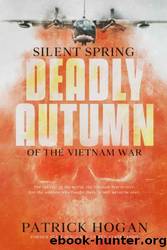Silent Spring - Deadly Autumn of the Vietnam War by Patrick Hogan

Author:Patrick Hogan [Hogan, Patrick]
Language: eng
Format: epub
ISBN: 9781732547421
Published: 2019-04-30T22:00:00+00:00
“Inert” Ingredients in Pesticides
Did you know that well over 1,600 active ingredients are used to create a multitude of different pesticides? However, the actual process of creating a pesticide consists of only two steps:
Step 1: Formulation of the chemicals
Step 2: The manufacturing process
Both steps involve the creation of planned reactions between chemicals in order to create an active ingredient for the particular pesticide being manufactured. The practices that occur within these two steps can potentially create toxic issues, harmful emissions, or hazardous waste materials, especially if the pesticide producer does not take proper safety precautions. Every pesticide is a specially designed combination of both active and inert ingredients. Active ingredients target and kill the pest or plant, while the inert components help the active chemicals work more efficiently and effectively, or so we’ve been told.
The fact is, these so-called inert components will not be tested as thoroughly (if they are tested at all) as the refined active ingredients might be. Plus, manufacturers are not required to disclose them on product labels, even though many inert ingredients may, on an individual level, be quite toxic. Thus, a chemical that’s listed as an active ingredient in one pesticide creation can, conversely, be categorized as an inert ingredient in an entirely different pesticide product.
The ingredient classification of active or inert is contingent almost wholly on the manufacturer’s designation. Consequently, in 1995, when the EPA evaluated a list of “inert” ingredients, it found that approximately 394 (or 16 percent) were or had been registered as active ingredients in other pesticide products.
In the real world—outside of laboratory applications—almost every inert ingredient is used to enhance the toxicity and application of the active ingredients. For that reason, “inert” erroneously implies that these additives and contaminants (e.g., dioxin, HCB, OSS-TMP, and other DLCs) do not have biological impacts or consequences. As a matter of fact, a 2006 study determined that inert additives actually make pesticides much more dangerous to humans than established by either our past or current safety testing standards.8
Regrettably, these last three chapters were just the small tip of the chemical iceberg. There are still many chemicals—both known and unknown—we veterans were exposed to; however, I think I made my point with just the few I noted. Besides, I’m pretty sure not everyone was having fun with this small portion of the chemistry that went into the Vietnam War. Even though a little complex, I hope these sections were enlightening and you gained some new insight into the number of toxic substances that veterans were really exposed to and the chemicals that our government didn’t tell you about. Unluckily, not only were the actual chemicals problematic, but there were also severe complications with the spraying of those pesticides.
Download
This site does not store any files on its server. We only index and link to content provided by other sites. Please contact the content providers to delete copyright contents if any and email us, we'll remove relevant links or contents immediately.
| Africa | Americas |
| Arctic & Antarctica | Asia |
| Australia & Oceania | Europe |
| Middle East | Russia |
| United States | World |
| Ancient Civilizations | Military |
| Historical Study & Educational Resources |
The Light of Days by Judy Batalion(1063)
First Platoon: A Story of Modern War in the Age of Identity Dominance by Annie Jacobsen(903)
Stalin's War: A New History of World War II by Sean McMeekin(861)
The Pacific War 1941-1943 by James Holland(803)
Walk in My Combat Boots by James Patterson(765)
The American War in Afghanistan by Carter Malkasian(743)
Victory's Price (Star Wars) by Alexander Freed(735)
The Vietnam War: An Intimate History by Geoffrey C. Ward & Ken Burns(721)
Blood and Ruins: The Great Imperial War, 1931-1945 by Richard Overy(686)
Operation Pedestal by Max Hastings(683)
Concepts of Space by Jammer Max;(667)
Cold War (Alexander King Book 2) by Bradley Wright(661)
Extreme Fitness by Chris McNab(654)
The Madman Theory by Jim Sciutto(651)
Flying Tiger by Samson Jack(635)
World War II Infantry Fire Support Tactics by Gordon L. Rottman(612)
Pathfinders by AL-KHALILI JIM(611)
Panzerkrieg by Mike Syron(601)
Hitler’s Pre-Emptive War: The Battle for Norway, 1940 by Henrik O. Lunde(585)
